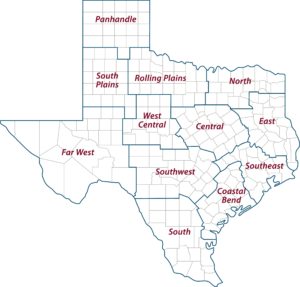Texas Corn Off to a Good Start
The majority of planted Texas corn acres have emerged amid good soil moisture profiles to start the growing season, said a Texas A&M AgriLife Extension Service expert.
Dr. Ronnie Schnell, AgriLife Extension agronomist, College Station, said the Texas corn crop started late in parts of the state, but growing conditions have planted fields off to a good start.

Wet field conditions delayed corn plantings in some parts of the state, according to a Texas A&M AgriLife Extension Service agronomist. (Texas A&M AgriLife Extension Service photo by Dr. Gaylon Morgan)
“Plantings were behind schedule two to three weeks in the upper Coastal Bend and Central Texas due to wet weather, before drier conditions in late March allowed producers to catch up,” he said. “Cooler temperatures have also delayed planting for some producers.”
The U.S. Department of Agriculture’s National Agricultural Statistics Service Prospective Planting report estimated 2.15 million acres would be planted in Texas this year. The report’s estimate represents a 50,000-acre reduction in corn acres for the state compared to last year.
The USDA reported 70 percent of Texas corn was planted with more than 60 percent of those acres emerged. A majority of those acres are in “good” to “excellent” condition so far.
Planted and emerged acres indicate producers in the High Plains and Panhandle have made progress, Schnell said. The regions typically account for 45 percent of Texas’ corn acres.
Schnell said some producers in wetter areas may have chosen options like cotton for their acres over planting corn late. Others held out and planted corn hoping good moisture and favorable weather would lead to good yield potential.
In-season field operations have been challenging as producers wait for fields to dry, Schnell said. If rains continue, nitrogen applications could be delayed and there are concerns about nitrogen loss reducing fertilizer efficiency.
“That’s the gamble,” he said. “Producers have to balance inputs like nitrogen based on yield potential and decide whether they can be more aggressive and take advantage of good conditions or to be more conservative in the event conditions become unfavorable.”
As always, weather through the rest of the season will determine producers’ outcomes despite the good start, Schnell said. Too much water can be as bad or worse than too dry for corn production.
“Central Texas is pretty wet after the recent line of storms,” he said. “We’re hoping the next round of storms does not produce flooding or saturation for an extended time because those conditions can cause problems.”
AgriLife Extension district reporters compiled the following summaries:

The 12 Texas A&M AgriLife Extension Districts
CENTRAL: Parts of the district received 3-7 inches of rain. Flooding was reported. Pastures needed sunshine, but more rain was in the forecast. Diseases in wheat were reported. Farmers were unable to access fields to plant cotton. Producers estimated 75 percent of planted cotton will have to be replanted. Cornfields were good overall in some areas but, excessive rains left 25-50 percent of corn covered by or standing in water. A few cornfields were showing stress from too much water. Livestock were doing well on native pasture. Nearly all counties reported excellent soil moisture levels. Most counties reported good overall rangeland, pasture and crop conditions.
ROLLING PLAINS: Conditions turned favorable for area producers as timely rain events continued, and area producers received several inches of rain. The soil moisture profile looked promising. Pastures and rangeland looked good, and livestock were in good condition with supplemental feeding occurring on a small scale. Farmers began preparing fields for the upcoming cotton crop. A small percentage of wheat in Baylor County was affected by hail. Peach and pecan producers in Clay County experienced tornado damage to orchards.
COASTAL BEND: Many areas received significant rainfall. Soil moisture levels were good in most areas and a little dry in others. Corn reached tassel stage and early planted sorghum was starting to head. A large amount of cotton was planted in northern parts of the district. Some cotton was replanted in the southern end of the district. Cotton made good progress with some reports of seedlings damaged by wind. Growers were top-dressingcorn in expectation of rain. Wheat was ready to harvest. Pastures were in excellent condition. Fertilizer and herbicide applications continued on pastures and hay fields. Livestock were in good condition. Pecan growers began spraying for first-generation pecan nut casebearer.
EAST: Severe weather with high winds and heavy rains continued to wreak havoc across the district. Downed trees were reported in Houston County. A tornado touched down in San Augustine County, taking down approximately five miles of livestock fencing. Pasture and rangeland conditions were mostly good. Subsoil and topsoil conditions were adequate with a few counties reporting a surplus. Many counties reported 3-4 inches of rain. Producers in Cherokee County were finding it hard to cut or bale for hay due to laid over ryegrass stands. Sabine County producers were studying the prospects of putting up haylage, baleage and silage instead of curing their hay. Saturated pastures in Wood County delayed fertilizer and lime applications. Much of the corn in Anderson County was underwater. Producers were unsure how much corn would survive, and it was too wet to prepare land for cotton or grain sorghum. Cattle were in good body condition, and prices were steady. Gnat and fly activity were increasing. Wild pigs were active and caused damages.
SOUTH PLAINS: Scattered storms delivered up to 3 inches of rain while some areas received no moisture. Some counties reported tornadic storms that produced rain and hail. There were no reports of damage to structures. Temperatures remained cool and wet. Producers in some counties will have to wait a few days to get into the fields. Some cotton was planted, but soil temperatures remained cool and the forecast was unfavorable. Pastures were looking good. Cattle were in decent condition.
PANHANDLE: Producers enjoyed small rain showers and moderate temperatures with some hail and high winds. Corn planting began in select areas. Plantings were in start-and-stop mode due to rain. While precipitation was received, moisture was not significant. Wheat progressed nicely. Cattle supplementation ended due to wheat being under ideal conditions.
NORTH: Soil moisture was adequate to surplus. Reported rainfall amounts were 3-8 inches across the district. Rains hindered fieldwork. Wheat, oats, sorghum and corn were saturated with water standing in places. Corn and sorghum looked good, but more rain may cause yellowing to occur. Wheat and oats looked good for the most part, at least where flooding didn’t cause it to lodge. Cattle had plenty of winter grass to eat. Hornflies were a problem. There were reports of armyworms.
FAR WEST: Average high temperatures were in the low 90s with lows in the low 50s. Severe thunder and hailstorms hit a large portion of the district. Rainfall amounts ranged from a trace up to 1 inch. Producers were having to feed more hay until grazing conditions improved. Alfalfa fields were hit by alfalfa weevil. All Pima cotton and around 90 percent of upland cotton was planted. Producers were beginning to work calves. Some cows were expected to begin calving at the end of May through June.
WEST CENTRAL: Most of the district received several more inches of rain. Forage conditions continued to improve, but weeds continued to flourish and were requiring management. Hay producers put out fertilizer ahead of the rains. Fields were really saturated again and should be good for cotton planting soon. Conditions were perfect for corn and sorghum. Wheat was finishing up and will be harvested in a month. Pastures were off to the best start in several years, which will help grazing. Livestock remained in fair to good condition with body condition scores improving weekly.
SOUTHEAST: Soil moisture continued to be adequate for rangeland, pasture and crop growth. Brazos County reported heavy rainfall and flooding across the Brazos Valley. The window for rice planting was coming to a close, and rains were not cooperating. While rains helped soil moisture levels, some farmers were behind on planting because they were unable to access fields. Rangeland and pasture ratings were excellent to poor with good being most common.
SOUTHWEST: Most counties received much-needed rain. Crops were in good shape and growing. Pastures responded well to wet conditions and warmer temperatures. Fertilization and weed control occurred in some areas. Spring sheep shearing continued. Livestock remained in good condition.
SOUTH: Northern parts of the district reported the continuation of mild weather conditions with adequate soil moisture levels. Western and eastern parts of the district reported wet weather conditions and short to adequate soil moisture levels. The southern part of Duval County received 3 inches of rainfall in a day. Hot weather and short moisture conditions were reported in southern parts of the district. Wheat fields were maturing and getting close to harvest. Wheat harvest started in some fields. Corn fields started moving into the reproductive stage. Cotton harvest was complete. Pastures and rangelands continued to improve in some areas and decline in others. Producers in some areas continued to supplement feed, and some were hauling water. Rangeland was beginning to stress in Starr County due to the lack of moisture. A few farmers were waiting to replant cotton destroyed by strong winds. Farmers planted a majority of the remaining crop acreage. Coastal Bermudagrass fields were producing hay bales. Most vegetable fields were planted and flowering. Onion harvest was expected to begin late next week. Some late-planted cabbage fields were reaching harvest stage. Corn and sorghum made good progress. Pecan producers continued to apply irrigation water to most orchards. Winter oats and wheat diminished due to heat, but haygrazer was doing well following recent rains.
Source: Texas AgriLife Extension
